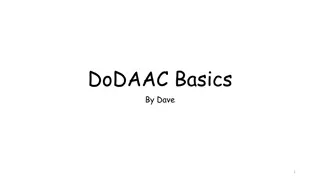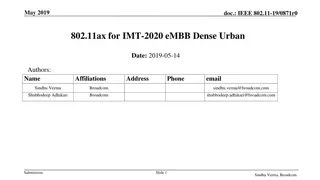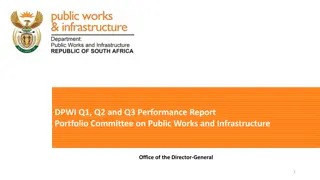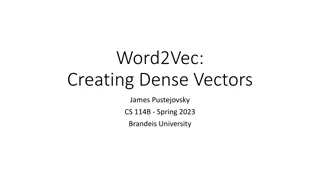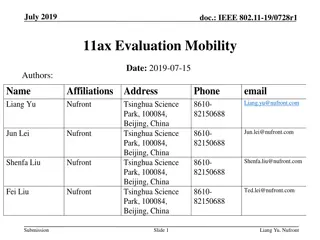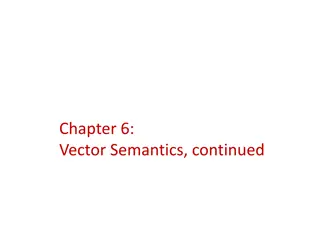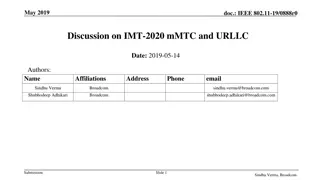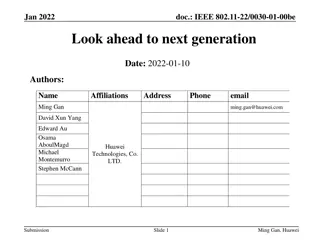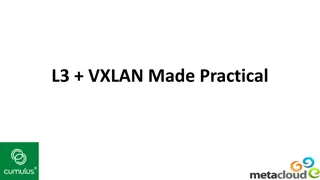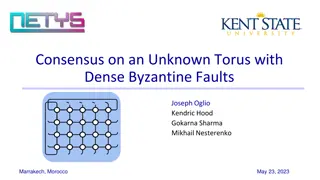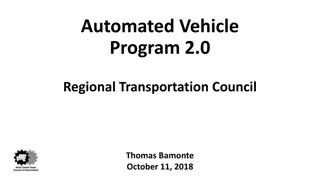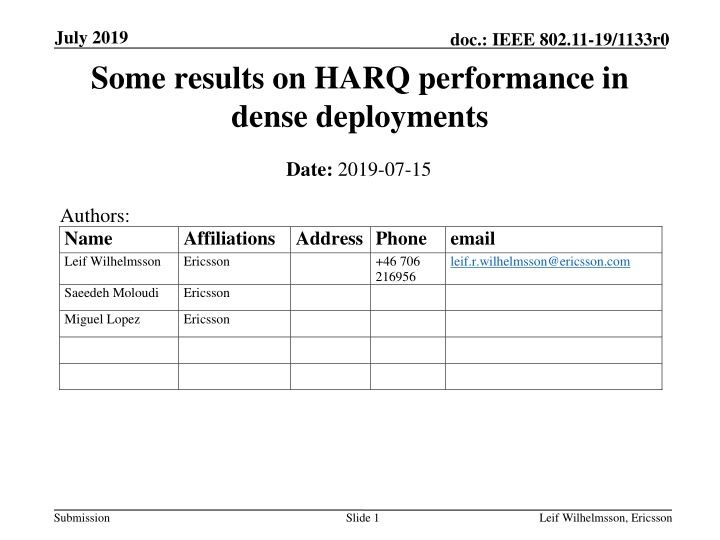
July 2019 Results on HARQ Performance in Dense Deployments
Explore the performance of HARQ in dense deployments through a multi-layer approach, enhancing channel use and reducing link adaptation needs. Addressing challenges in unpredictable interference, this study presents insights on effective channel utilization and the role of MCS in maximizing information extraction with HARQ.
Download Presentation

Please find below an Image/Link to download the presentation.
The content on the website is provided AS IS for your information and personal use only. It may not be sold, licensed, or shared on other websites without obtaining consent from the author. If you encounter any issues during the download, it is possible that the publisher has removed the file from their server.
You are allowed to download the files provided on this website for personal or commercial use, subject to the condition that they are used lawfully. All files are the property of their respective owners.
The content on the website is provided AS IS for your information and personal use only. It may not be sold, licensed, or shared on other websites without obtaining consent from the author.
E N D
Presentation Transcript
July 2019 Some results on HARQ performance in dense deployments doc.: IEEE 802.11-19/1133r0 Date: 2019-07-15 Authors: Name Leif Wilhelmsson Affiliations Address Phone Ericsson email leif.r.wilhelmsson@ericsson.com +46 706 216956 Saeedeh Moloudi Ericsson Miguel Lopez Ericsson Submission Slide 1 Leif Wilhelmsson, Ericsson
July 2019 doc.: IEEE 802.11-19/1133r0 Abstract HARQ is a one of the features considered for EHT in order to enhance the performance In this contribution we present a slightly different way to introduce HARQ, by using a multi-layer approach [1]. Multi-layer transmission allows for a more opportunistic use of the channel and considerably reduces the need for link adaptation. Both these properties are advantages when the signal-to- interference at the receiver is highly unpredictable as e.g. in dense deployments Submission Slide 2 Leif Wilhelmsson, Ericsson
July 2019 doc.: IEEE 802.11-19/1133r0 Outline Background/Motivation Basic idea Simulation results Straw Poll Submission Slide 3 Leif Wilhelmsson, Ericsson
July 2019 doc.: IEEE 802.11-19/1133r0 Background/Motivation To make effective use of the channel, a proper MCS must be used This assumes knowledge of the channel In dense deployments where the link is interference limited, this is not possible as the experienced interference is essentially random (uncorrelated from one time instant to the next) Submission Slide 4 Leif Wilhelmsson, Ericsson
July 2019 doc.: IEEE 802.11-19/1133r0 Background/Motivation If the MCS is too low, the channel is not efficiently used If the MCS is too high, a retransmission is needed With HARQ, this is less of a problem since still some information is extracted and can be used for successive transmissions However, it comes at the expense of increased delay/jitter In an ideal case, one should use a high MCS in an opportunistic way If the channel is good this can be explored If the channel is poor, one should still be able to extract as much information as the channel allows for Submission Slide 5 Leif Wilhelmsson, Ericsson
July 2019 doc.: IEEE 802.11-19/1133r0 Basic idea Multi-layer modulation The problem of unknown channel conditions for the receiver resemble that of broadcast communication in that the channel may be very different for different for different receivers => Not possible for the transmitter to optimize for a specific receiver, but a receiver should do the best out of the situation In [1], the broadcasting problem is analyzed theoretically. Motivated by the need to obtain high efficiency at low latency Here a very pragmatic approach is taken to improve performance with a minimum of changes Submission Slide 6 Leif Wilhelmsson, Ericsson
July 2019 doc.: IEEE 802.11-19/1133r0 Basic idea Multi-layer modulation The different bits in a received symbol carry different amount of information[2] Normally the average conditions of the received bits determines whether the decoding is successful In multi-layer transmission, the difference in relibility is instead exploited Slide 7 Submission Leif Wilhelmsson, Ericsson
July 2019 doc.: IEEE 802.11-19/1133r0 Multi-layer modulation Example 1 Codeword 1, using b1- b4 Codeword 2, using b1-b4 Codeword 1, using b1 and b2 Codeword 2, using b3 and b4 Interleaved Layer 1&2 Layer 3&4 Example (ideal decoding): With a rate code and ideal decoding, one must extract 1 bit of information for every 2 codebits. Then the coding will succeed, otherwise not In the example above, this means 5 dB needed when the bits are interleaved 2.5 dB and 7 dB are needed for respective layer if not interleaved Multi-layer means no interleaving of bit with different reliability Submission Slide 8 Leif Wilhelmsson, Ericsson
July 2019 doc.: IEEE 802.11-19/1133r0 Multi-layer modulation Example 2 Rather than looking at the information rate, one may look at the codeword error probability The figure above shows simulation results for a LDPC code with H matrix (1944,972) in combination with 256-QAM There are 8 layers, two at each robustness level Submission Slide 9 Leif Wilhelmsson, Ericsson
July 2019 doc.: IEEE 802.11-19/1133r0 Simulation results Simulation set-up To benchmark multi-layer HARQ with the standard approach , the following approach was taken: 16/64/256-QAM and (1944,972) LDPC was used In each transmission 4/6/8 codewords are transmitted using 1944 symbols. For multi-layer, these are sent in parallel. For the standard approach the codewords are sent one after the other In both cases 1944 symbols are used. The channel is static for the 1944 symbols, then possibly varied in between each transmission HARQ with Chase combining is used. For multi-layer, the same layer is used for retransmission The figure of merit is how many transmissions are needed to correctly receiver 1000 codewords Submission Slide 10 Leif Wilhelmsson, Ericsson
July 2019 doc.: IEEE 802.11-19/1133r0 Simulation results - AWGN For an AWGN channel, with the right SNR (perfect LA), the interleaved approach gives the best results. The reason is that the least robust layer for multi-layer transmission will fail Noticible is that for lower SNR, the degradation is much more graceful. The degradation reflects worse channel conditions rather than a significant mismatch between channel and used MCS Recall: If the channel is poor, one should still be able to extract as much information as the channel allows for Slide 11 Submission Leif Wilhelmsson, Ericsson
July 2019 doc.: IEEE 802.11-19/1133r0 Simulation results Varying channel (1) Instead of an AWGN channel, where proper LA is feasible, a time- varying channel was considered The effective SNR is uniformly distibuted between [SNR-10 SNR], i.e., it is assumed that random interference appears such that the effecive SNR is reduced by 0 and 10 dB in a uniform fashion. => There is no SNR where standard transmission outperforms multi-layer transmission Submission Slide 12 Leif Wilhelmsson, Ericsson
July 2019 doc.: IEEE 802.11-19/1133r0 Simulation results Varying channel (2) conditions To see the robustness to multi-layer transmission, 256-QAM is compared to the best of 16/64/256 QAM standard transmission Essentially, with multi-layer transmission, there is little need for link adaptation, 256-QAM works well independent of SNR Submission Slide 13 Leif Wilhelmsson, Ericsson
doc.: IEEE 802.11-19/1133r0 July 2019 Straw Poll Do you believe multi-layer transmission should be considered for EHT? Y/N/A: Submission Slide 14 Leif Wilhelmsson,
July 2019 doc.: IEEE 802.11-19/1133r0 References 1. Multi-layer broadcasting Hybrid-ARQ strategies for block fading channels , A. Steiner and A. Shamai (Shitz), IEEE Trans. On Wireless Comm. July 2008. 2. Coding performance of HARQ with BICM Part I: Unified performance analysis , J.-F. (T.) Cheng, PIMRC 2010 Submission Slide 15 Leif Wilhelmsson, Ericsson




